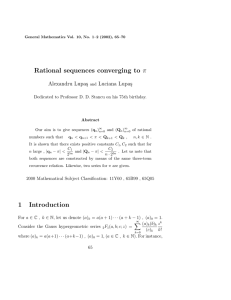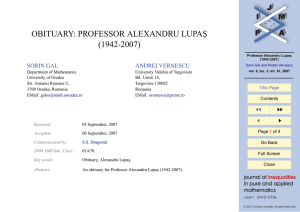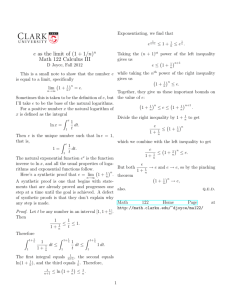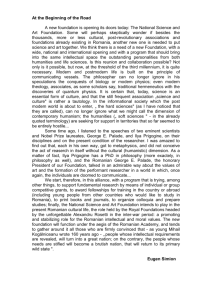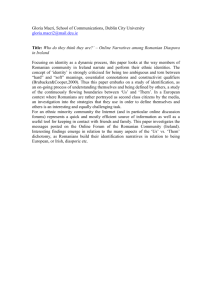About the use of a result of Professor Alexandru Lupa¸
advertisement
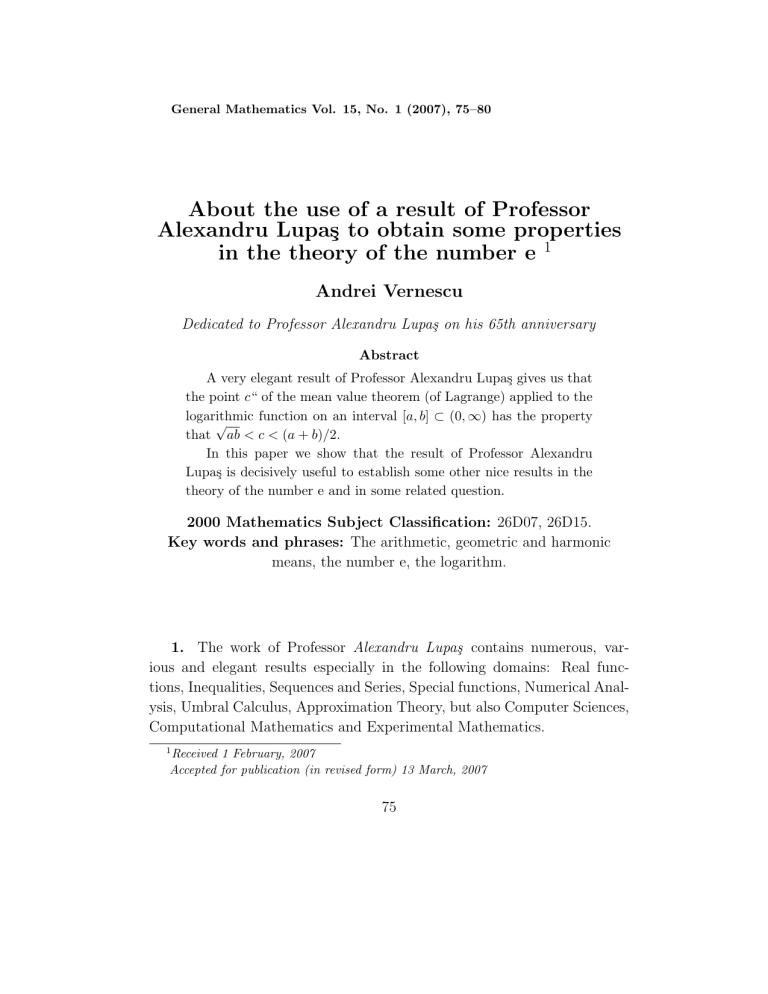
General Mathematics Vol. 15, No. 1 (2007), 75–80 About the use of a result of Professor Alexandru Lupaş to obtain some properties in the theory of the number e 1 Andrei Vernescu Dedicated to Professor Alexandru Lupaş on his 65th anniversary Abstract A very elegant result of Professor Alexandru Lupaş gives us that the point c“ of the mean value theorem (of Lagrange) applied to the logarithmic function on an interval [a, b] ⊂ (0, ∞) has the property √ that ab < c < (a + b)/2. In this paper we show that the result of Professor Alexandru Lupaş is decisively useful to establish some other nice results in the theory of the number e and in some related question. 2000 Mathematics Subject Classification: 26D07, 26D15. Key words and phrases: The arithmetic, geometric and harmonic means, the number e, the logarithm. 1. The work of Professor Alexandru Lupaş contains numerous, various and elegant results especially in the following domains: Real functions, Inequalities, Sequences and Series, Special functions, Numerical Analysis, Umbral Calculus, Approximation Theory, but also Computer Sciences, Computational Mathematics and Experimental Mathematics. 1 Received 1 February, 2007 Accepted for publication (in revised form) 13 March, 2007 75 76 Andrei Vernescu All these result can be found in his numerous papers and books. In this paper we consider one of his most elegant results, namely concerning the position of the point ,,c“ of the mean value theorem (of Lagrange) applied to the logarithmic function on an interval [a, b] ⊂ (0, ∞). This point, given by the equation: (1) f (b) − f (a) = f ′ (c) · (b − a), for f (x) = ln x, x ∈ [a, b] ⊂ (0, ∞) and unique because of the injectivity of the derivative has the property: (2) √ ab < c < a+b . 2 This property refines the relation c ∈ (a, b), because, of course ³√ ´ ab, (a + b)/2 ⊂ (a, b). So it gives an answer from a celebrated question proposed by D. Pompeiu: to find for the point ,,c“ smaller intervals as (a, b) (see [8], at the pages 201, 273, 293; also, see [1]). 2. To prove the two-sided inequality (2) consider the following Lemma ([7], page 273). For any x > 0, we have: µ ¶ 1 1 2 (3) . < ln 1 + <p 2x + 1 x x(x + 1) Proof. For the left part, consider the function f : (0, ∞) → R, ¢ ¡ 1 . Because of the equality f (x) = ln 1 + x1 − 2x+1 f ′ (x) = − 1 < 0, x(x − 1)(2x + 1)2 the function f is strictly decreasing. The comparison with lim f (x) = 0, x→∞ closes the proof. About the use of a result of Prof. Alexandru Lupaş to obtain... 77 Analogously, for the right part, consider the function g : (0, ∞) → R, ¢ ¡ g(x) = ln 1 + x1 − √ 1 . We obtain x(x+1) 2 p g (x) = 2x(x + 1) x(x + 1) ′ µ ¶ 2x + 1 p − x(x + 1) > 0 2 and so, because of the comparison with lim g(x) = 0, we obtain the right x→∞ part. Theorem 1. For any interval (a, b) ⊂ (0, ∞), a < b, considering the point ,,c“ previously defined in the section 1, we have the inequality (2). Proof. The formula (1), written for the logarithmic function becomes and (2) is equivalent with: ln b − ln a = b−a c (4) or with: (5) 2(b − a) b b−a < ln < √ , b+a a ab 2(t − 1) t−1 < ln t < √ , t+1 t where t = b/a and t > 1. If we put e = 1 + 1/s, with s > 0, the inequality (5) becomes ¶ µ e 1 1 , <p < ln 1 + 2s + 1 s s(s + 1) which is exactly (3), written in the variable s in the place of x, therefore it is true. We remark now that, conversely, (3) implies (4). Indeed, putting in (3) x = ab − 1, it gives us (4). So we have obtained the Theorem 2. The following affirmation are equivalent: (a) The point ,,c“ of the mean theorem for the logarithmic function, applied on an interval [a, b] ⊂ (0, ∞) satisfies the inequality (2). (b) The inequality (3) is true. 3. The inequality (4) can be also interpreted in two manners (for 0 < a < b): 78 Andrei Vernescu (a) It is a reffinement of the classical inequality of Napier : b b−a b−a < ln < . b a a (b) The logaritmical mean of a and b, namely lnb−a is placed between b/a the geometric and the arithmetic means of a and b. 4. The property of the point ,,c“ of the logarithmic function, given by Professor Alexandru Lupaş permits us to obtain other nice results. (a) We have the inequality (from [9]): µ ¶n e 1 e < (6) <e− 1+ . 2n + 2 n 2n + 1 For a short proof, based on (3), see [13]. (b)If γn = 1 + 12 + 31 + . . . + n1 − ln n and γ = lim γm = 0, 577 . . . is the n→∞ Euler, s constant, we have: 1 1 < γn − γ < . 2n + 1 2n (7) A proof based on (3) can be given in [12]. (c) It is known that the unique rational solutions of the equation: xy = y x (0 < x < y) , µ are given by: x = en = µ 1 1+ n ¶n y = fn = 1 1+ n ¶n+1 (n = 1, 2, 3 . . .) (see [15], pp. 242-256). This means that replacing these solutions in the equation, we obtain a true equality, namely: n+1 ¶ (n+1) µ n n n+1 . efnn = fnen = n n+1 ¡ n+1 ¢ (n+1) nn be. The sequence is strictly decreasing. For the Let zn = n proof, see [14]. This proof uses again (3). About the use of a result of Prof. Alexandru Lupaş to obtain... 79 A similar situation is valid for the rational solutions of the equation u = v v (0 < v < u). We have u = e1n , v = f1n and so: u µ 1 en ¶ e1 n = µ 1 fn ¶ f1 n = µ n n+1 n+1 ¶ (n+1) nn . n+1 ¶ (n+1) nn n Let wn = be. The sequence is also strictly decreasing; n+1 the proof of [14] uses, again, (3). (d) The problem [6] of Professor Alexandru Lupaş is the following: ,,Let x and y be two different real numbers x > 0, y > 0, x 6= e so that xy = y x . Show that xy > ee .“ The solution, published in the same journal in 2006, no. 3, pp. 233-236, also uses (3). (e) In the paper [2], the sequences of general term ηn = en ln(En ) = ¶n+1 µ 1 , are = En ln(en ) and λn = ln(en ) · ln(En ), where En = fn = 1 + n studied. In the proof of a part of its properties, (3) is also used. (f) In the problem [3] the sequence (xn )n is defined by the equality µ ¶n+xn 1 1+ = e. The monotony and the convergence are requested. To n solve the problem the inequality (3) are again necesary. A similar situation is related to [10], where the properties of the sequence 1 1 1 (xn )n given by the equality 1+ + +. . .+ −ln(x+xn ) = γ are requested. 2 3 n The inequality (3) are again used. Also se [11]. µ References [1] G. Şt. Andonie, The History of the Mathematics in Romania (in Romanian), Ed. of Sciences, Bucharest, 1965. [2] E. Constantinescu, A. Lupaş and A. Vernescu, About two Sequences related to Napier, s Constant, JIAT, Vol. 1 (2007), No. 1 (to appear). [3] L. Lazarovici, B. Ramazan, The Problem 20383 (in Romanian), Gazeta Mat. vol 100 (1985), No. 3, p. 94. 80 Andrei Vernescu [4] A. Lupaş, The Problem 12739 (in Romanian), Gazeta Mat. vol 78 (1973), No. 2, p. 108. [5] A. Lupaş, About the Theorem of the finite increasings (in Romanian), Rev. Mat. Timişoara, vol. 14 (1983), No. 2, 6-13. [6] A. Lupaş, The problem 203 (in Romanian), Gazeta Mat. (Series A), vol. 23 (102), 2005, no. 1, p. 280. 91 (1986). [7] D.S. Mitrinović and P.M. Vasić, Analytic Inequalities, Springer-Verlag, Berlin Heidelberg New York, 1970. [8] D. Pompeiu, The Mathematical Work (in Romanian), Printing House of the Romanian Academy, Bucharest, 1957. [9] G. Pólya, G. Szegö, Problems and Theorems in Analysis, SpringerVerlag, Berlin Heidelberg New York, 1970. [10] B. Ramazan, L. Lazarovici, The Problem C608, Gazeta Mat. vol 91 (1986). [11] L.Tóth, About the Problem C608 (in Romanian), Gazeta Mat. vol 94 (1989), 277-279. [12] A. Vernescu, The Order of Covergence of the Sequence of Definition of the Number e (in Romanian), Gazeta Mat. (Series A), vol. 88 (1983), 580-281. [13] A. Vernescu, A simple Proof of an Inequality related to the Number e (in Romanian), Gazeta Mat. vol. 93 (1988), 205-206. [14] A. Vernescu, On The Monotony of some Sequences concerning the Equations xy = y x and uu = v v , Lucr. Sem. Didactica Matematicii, vol. 13 (1998), 229-232. [15] A. Vernescu, The number e and the Mathematics of the Exponential, Publishing House of the University of Bucharest, 2004 (in Romanian). About the use of a result of Prof. Alexandru Lupaş to obtain... Valahia“ University,Târgovişte Department of Mathematics, 18 Bd. Unirii, 130082 Târgovişte E-mail address: avernescu@clicknet.ro 81
